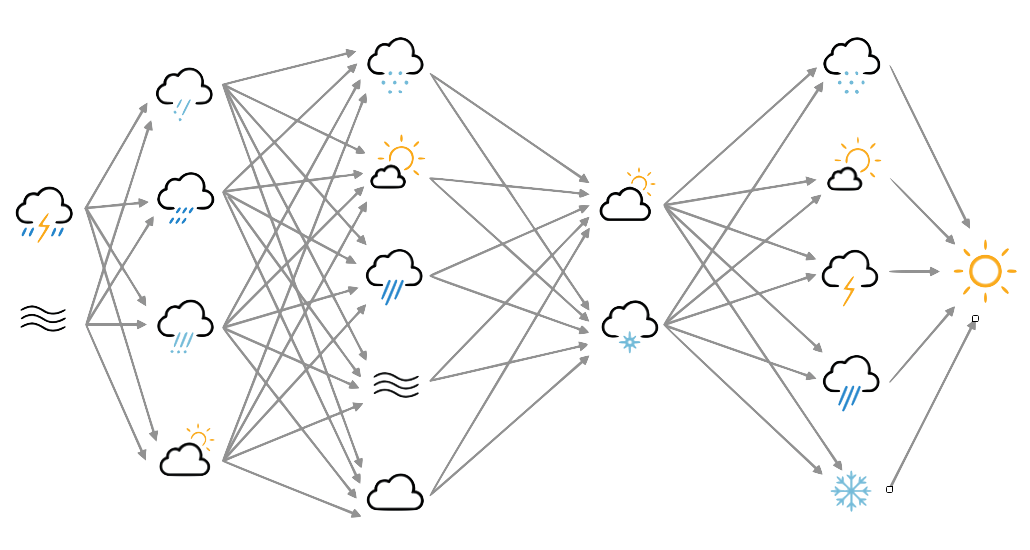An all-convolutional autoencoder with an explicit latent space¶
An autoencoder transforms an explicit, high-dimensional representation into lower-dimensional version. It’s convenient to represent the compressed state as a vector in an explicit latent space.
Then the code is the same as for the all-convolutional autoencoder with optimised training data, except that an additional, fully-connected, layer is added to form the latent space:
#!/usr/bin/env python
# Convolutional autoencoder for 20CR prmsl fields.
# This version is all-convolutional - it uses strided convolutions
# instead of max-pooling, and transpose convolution instead of
# upsampling.
# This version uses scaled input fields that have a size (79x159) that
# match the strided convolution upscaling and downscaling.
# It also works on tensors with a rotated pole - so the data boundary
# is the equator - this limits the problems with boundary conditions.
#
# This version also compresses the encoded field into a latent space.
import os
import sys
import tensorflow as tf
#tf.enable_eager_execution()
import ML_Utilities
import pickle
import numpy
# Dimensionality of the latent space
latent_dim=100
# How many epochs to train for
n_epochs=250
# Create TensorFlow Dataset object from the prepared training data
(tr_data,n_steps) = ML_Utilities.dataset(purpose='training',
source='rotated_pole/20CR2c',
variable='prmsl')
tr_data = tr_data.repeat(n_epochs)
# Also produce a tuple (source,target) for model
def to_model(ict):
ict=tf.reshape(ict,[79,159,1])
return(ict,ict)
tr_data = tr_data.map(to_model)
tr_data = tr_data.batch(1)
# Similar dataset from the prepared test data
(tr_test,test_steps) = ML_Utilities.dataset(purpose='test',
source='rotated_pole/20CR2c',
variable='prmsl')
tr_test = tr_test.repeat(n_epochs)
tr_test = tr_test.map(to_model)
tr_test = tr_test.batch(1)
# Input placeholder
original = tf.keras.layers.Input(shape=(79,159,1,))
# Encoding layers
x = tf.keras.layers.Conv2D(16, (3, 3), padding='same')(original)
x = tf.keras.layers.LeakyReLU()(x)
x = tf.keras.layers.Conv2D(8, (3, 3), strides= (2,2), padding='valid')(x)
x = tf.keras.layers.LeakyReLU()(x)
x = tf.keras.layers.Conv2D(4, (3, 3), strides= (2,2), padding='valid')(x)
x = tf.keras.layers.LeakyReLU()(x)
x = tf.keras.layers.Conv2D(2, (3, 3), strides= (2,2), padding='valid')(x)
x = tf.keras.layers.LeakyReLU()(x)
# N-dimensional latent space representation
x = tf.keras.layers.Reshape(target_shape=(9*19*2,))(x)
encoded = tf.keras.layers.Dense(latent_dim)(x)
# Decoding layers
x = tf.keras.layers.Dense(9*19*2)(encoded)
x = tf.keras.layers.Reshape(target_shape=(9,19,2,))(x)
x = tf.keras.layers.Conv2DTranspose(2, (3, 3), strides= (2,2), padding='valid')(x)
x = tf.keras.layers.LeakyReLU()(x)
x = tf.keras.layers.Conv2DTranspose(4, (3, 3), strides= (2,2), padding='valid')(x)
x = tf.keras.layers.LeakyReLU()(x)
x = tf.keras.layers.Conv2DTranspose(8, (3, 3), strides= (2,2), padding='valid')(x)
x = tf.keras.layers.LeakyReLU()(x)
decoded = tf.keras.layers.Conv2D(1, (3, 3), padding='same')(x)
# Model relating original to output
autoencoder = tf.keras.models.Model(original,decoded)
# Choose a loss metric to minimise (RMS)
# and an optimiser to use (adadelta)
autoencoder.compile(optimizer='adadelta', loss='mean_squared_error')
# Train the autoencoder
history=autoencoder.fit(x=tr_data,
epochs=n_epochs,
steps_per_epoch=n_steps,
validation_data=tr_test,
validation_steps=test_steps,
verbose=2) # One line per epoch
# Save the model
save_file=("%s/Machine-Learning-experiments/"+
"convolutional_autoencoder_perturbations/"+
"latent_space/saved_models/Epoch_%04d") % (
os.getenv('SCRATCH'),n_epochs)
if not os.path.isdir(os.path.dirname(save_file)):
os.makedirs(os.path.dirname(save_file))
tf.keras.models.save_model(autoencoder,save_file)
history_file=("%s/Machine-Learning-experiments/"+
"convolutional_autoencoder_perturbations/"+
"latent_space/saved_models/history_to_%04d.pkl") % (
os.getenv('SCRATCH'),n_epochs)
pickle.dump(history.history, open(history_file, "wb"))
It takes longer to train, and the quality of the reconstruction is somewhat reduced, but with a 100-dimensional latent space the quality is not too bad.

Top, a sample pressure field: Original in red, after passing through the autoencoder in blue. Bottom, a scatterplot of original v. encoded pressures for the sample field, and a graph of training progress: Loss v. no. of training epochs.
Script to make the figure¶
#!/usr/bin/env python
# Model training results plot
import tensorflow as tf
tf.enable_eager_execution()
import numpy
import IRData.twcr as twcr
import iris
import datetime
import argparse
import os
import math
import pickle
import Meteorographica as mg
import matplotlib
from matplotlib.backends.backend_agg import FigureCanvasAgg as FigureCanvas
from matplotlib.figure import Figure
import cartopy
import cartopy.crs as ccrs
# Function to resize and rotate pole
def rr_cube(cbe):
# Use the Cassini projection (boundary is the equator)
cs=iris.coord_systems.RotatedGeogCS(0.0,60.0,270.0)
# Latitudes cover -90 to 90 with 79 values
lat_values=numpy.arange(-90,91,180/78)
latitude = iris.coords.DimCoord(lat_values,
standard_name='latitude',
units='degrees_north',
coord_system=cs)
# Longitudes cover -180 to 180 with 159 values
lon_values=numpy.arange(-180,181,360/158)
longitude = iris.coords.DimCoord(lon_values,
standard_name='longitude',
units='degrees_east',
coord_system=cs)
dummy_data = numpy.zeros((len(lat_values), len(lon_values)))
dummy_cube = iris.cube.Cube(dummy_data,
dim_coords_and_dims=[(latitude, 0),
(longitude, 1)])
n_cube=cbe.regrid(dummy_cube,iris.analysis.Linear())
return(n_cube)
# Get the 20CR data
ic=twcr.load('prmsl',datetime.datetime(2009,3,12,18),
version='2c')
ic=rr_cube(ic.extract(iris.Constraint(member=1)))
# Get the autoencoder
model_save_file=("%s/Machine-Learning-experiments/"+
"convolutional_autoencoder_perturbations/"+
"latent_space/saved_models/Epoch_%04d") % (
os.getenv('SCRATCH'),250)
autoencoder=tf.keras.models.load_model(model_save_file)
# Normalisation - Pa to mean=0, sd=1 - and back
def normalise(x):
x -= 101325
x /= 3000
return x
def unnormalise(x):
x *= 3000
x += 101325
return x
fig=Figure(figsize=(9.6,10.8), # 1/2 HD
dpi=100,
facecolor=(0.88,0.88,0.88,1),
edgecolor=None,
linewidth=0.0,
frameon=False,
subplotpars=None,
tight_layout=None)
canvas=FigureCanvas(fig)
# Top - map showing original and reconstructed fields
projection=ccrs.RotatedPole(pole_longitude=60.0,
pole_latitude=0.0,
central_rotated_longitude=270.0)
ax_map=fig.add_axes([0.01,0.51,0.98,0.48],projection=projection)
ax_map.set_axis_off()
extent=[-180,180,-90,90]
ax_map.set_extent(extent, crs=projection)
matplotlib.rc('image',aspect='auto')
# Run the data through the autoencoder and convert back to iris cube
pm=ic.copy()
pm.data=normalise(pm.data)
ict=tf.convert_to_tensor(pm.data, numpy.float32)
ict=tf.reshape(ict,[1,79,159,1])
result=autoencoder.predict_on_batch(ict)
result=tf.reshape(result,[79,159])
pm.data=unnormalise(result)
# Background, grid and land
ax_map.background_patch.set_facecolor((0.88,0.88,0.88,1))
#mg.background.add_grid(ax_map)
land_img_orig=ax_map.background_img(name='GreyT', resolution='low')
# original pressures as red contours
mg.pressure.plot(ax_map,ic,
scale=0.01,
resolution=0.25,
levels=numpy.arange(870,1050,7),
colors='red',
label=False,
linewidths=1)
# Encoded pressures as blue contours
mg.pressure.plot(ax_map,pm,
scale=0.01,
resolution=0.25,
levels=numpy.arange(870,1050,7),
colors='blue',
label=False,
linewidths=1)
mg.utils.plot_label(ax_map,
'%04d-%02d-%02d:%02d' % (2009,3,12,6),
facecolor=(0.88,0.88,0.88,0.9),
fontsize=8,
x_fraction=0.98,
y_fraction=0.03,
verticalalignment='bottom',
horizontalalignment='right')
# Scatterplot of encoded v original
ax=fig.add_axes([0.08,0.05,0.45,0.4])
aspect=.225/.4*16/9
# Axes ranges from data
dmin=min(ic.data.min(),pm.data.min())
dmax=max(ic.data.max(),pm.data.max())
dmean=(dmin+dmax)/2
dmax=dmean+(dmax-dmean)*1.05
dmin=dmean-(dmean-dmin)*1.05
if aspect<1:
ax.set_xlim(dmin/100,dmax/100)
ax.set_ylim((dmean-(dmean-dmin)*aspect)/100,
(dmean+(dmax-dmean)*aspect)/100)
else:
ax.set_ylim(dmin/100,dmax/100)
ax.set_xlim((dmean-(dmean-dmin)*aspect)/100,
(dmean+(dmax-dmean)*aspect)/100)
ax.scatter(x=pm.data.flatten()/100,
y=ic.data.flatten()/100,
c='black',
alpha=0.25,
marker='.',
s=2)
ax.set(ylabel='Original',
xlabel='Encoded')
ax.grid(color='black',
alpha=0.2,
linestyle='-',
linewidth=0.5)
# Plot the training history
history_save_file=("%s/Machine-Learning-experiments/"+
"convolutional_autoencoder_perturbations/"+
"latent_space/saved_models/history_to_%04d.pkl") % (
os.getenv('SCRATCH'),250)
history=pickle.load( open( history_save_file, "rb" ) )
ax=fig.add_axes([0.62,0.05,0.35,0.4])
# Axes ranges from data
ax.set_xlim(0,len(history['loss']))
ax.set_ylim(0,numpy.max(numpy.concatenate((history['loss'],
history['val_loss']))))
ax.set(xlabel='Epochs',
ylabel='Loss (grey) and validation loss (black)')
ax.grid(color='black',
alpha=0.2,
linestyle='-',
linewidth=0.5)
ax.plot(range(len(history['loss'])),
history['loss'],
color='grey',
linestyle='-',
linewidth=2)
ax.plot(range(len(history['val_loss'])),
history['val_loss'],
color='black',
linestyle='-',
linewidth=2)
# Render the figure as a png
fig.savefig("comparison_results.png")
